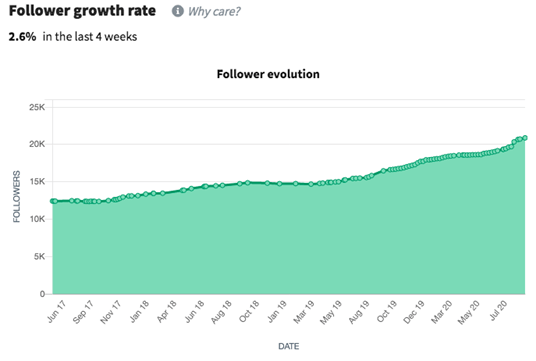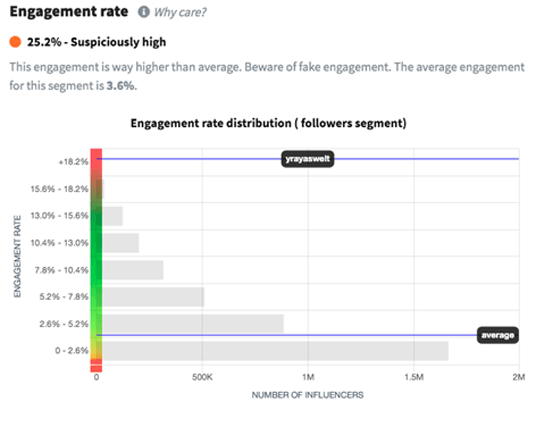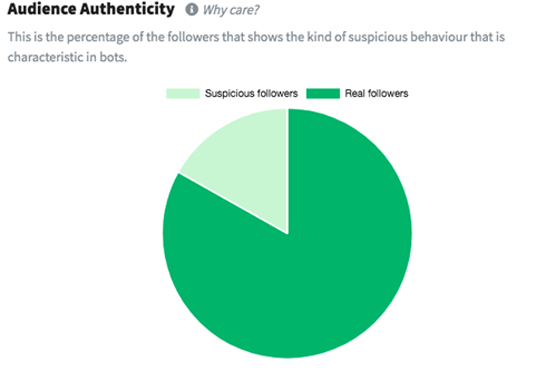The Rise of the Micro Influencer
If you’ve ever engaged in influencer marketing campaigns, chances are you’ve heard about the new stars of the industry: micro influencers.
The audience authenticity metric can help you determine if an influencer’s followers are for real
Brands have realised you don’t need 1M followers to launch a successful campaign. In 2019, 10 micro influencers were used for every celebrity influencer, a big boost from the 3:1 ratio recorded in 2016. But what makes them so attractive to marketers?
In this article, we’ll walk you through why micro influencers have risen within the industry, what you need to be aware of when hiring them, and some tips about using them in your own campaigns.
Why are micro influencers so popular?
Influencers can be sorted, based on their number of followers, into five influencer tiers. Micro influencers have relatively few followers, but that’s not necessarily a bad thing. What micro influencers lack in number of followers, they make up for in engagement, authenticity and value.
They have high engagement rates
As a general rule, the more followers you accumulate on social media, the more your engagement drops off. It’s more difficult to manage a community of 1M followers than 10K. Micro influencers are in the sweet spot of having enough followers to attract brands, but few enough to manage their social community with a personal touch.
Moreover, their audience trusts their voice and their content. Micro influencers don’t have the fame and gloss that top influencers do. They are real people who their audience relates with. And as they haven’t yet begun a constant rotation of brand collaborations, micro influencers also project authenticity in their opinions. In fact, 82% of consumers said they’re likely to buy something recommended by a micro influencer.

They have a stake in niche markets
Once influencers start to get very famous, their followers vary more. They come from different countries and have varying interests. Many might just follow the influencer for their name. But, while micro influencers don’t have millions of followers spread out across the world, they are powerful voices in niche markets. They retain laser-focused fan bases who look up to them as experts in their chosen field.

They are willing to collaborate for product
Micro influencers have also become so popular because of their price tag. Most of them will collaborate with brands in exchange for product alone. And those who request a fee generally don’t ask for much.
Although you may not reach as many followers as with a top influencer, the people you do reach will be more engaged with the campaign content, which means more engagement with your brand. A lower price tag combined with higher engagement translates into a better ROI.
How can you spot fake micro influencers?
Micro influencers are relatively new to the influencing industry, and this might cause some of them to want to get ahead by giving their profile an unnatural boost. When searching for micro influencers for your social media campaigns, make sure you know how to analyse their profiles and spot signs of fake followers or engagement.
Although you may not reach as many followers as with a top influencer, the people you do reach may well be more engaged with the campaign content
While you can extract this information from Instagram, it’s much easier to use an influencer marketing platform to help you more efficiently analyse influencers’ stats.
Check their follower growth
Follower growth rate shows how an influencer has accumulated followers over time. Micro influencers should be growing their follower base with quality content, and healthy follower rate should be a steady climb.

However, if you notice a sudden spike in followers, something might be funny. First, check if the influencer recently hosted a giveaway. Giveaways almost always require a follow, and people love free stuff, so that could account for a dramatic boost. If there’s no recent giveaway, spikes could show that the influencer bought fake followers.
Compare their engagement rate
Micro influencers generally have higher engagement than top influencers. That’s true. But what if a micro influencer has an extremely high engagement rate when compared to their peers in the same tier? Well, it could show that they’ve purchased fake likes or comments.

Take a look at their audience
While you may not be able to easily get this information directly from social media, influencer marketing software can help you assess the authenticity of an influencer’s audience. AI can notice behavior that is typical of bots, and give you an estimation of the percentage of the audience that is legitimate.

If you see a high percentage of potentially fake followers, take a look directly on social media. Bots typically don’t speak in a natural way, and may leave inappropriate or unrelated comments. They might not have a profile picture or any content of their own. If you see a lot of bots in an influencer’s followers, forget about that profile. You don’t want to market to computer programs.
Tips for working with micro influencers
There are a few things to take into account when collaborating with micro influencers.
Make your message clear
Before you even reach out to influencers, you should have your campaign defined. And one of the most important aspects of that is the message you want to transmit. What do you want to emphasize about your brand?
When you decide to collaborate with a micro influencer, explain to them clearly what message you want to send. The better they understand, the better they can create the content you’re looking for.
Give them creative freedom
Although you control your brand’s message, don’t micromanage a micro influencer’s content. Give them creative freedom to create content that’s authentic to them. They have grown their audience with their voice, so they best know how to deliver your message to their followers.
That being said, just as it’s important to make your brand message clear, it’s necessary that you stipulate any requirements you have for the campaign content. Let micro influencers know if you want them to use a specific hashtag or mention. Or maybe you want them to shoot their content in a specific place. For example, if you’re a swimwear brand and you want your campaign content to be set at the beach as opposed to the pool, tell your influencers that.
Give them time
Micro influencers may need a bit more time to publish their content. Many of them still have regular jobs. They might be nurses, teachers or shop assistants outside of social media, and so they can’t dedicate 100% of their time to your campaign.
Further, they’re still learning the ropes. It might take them longer to shoot, edit and publish than influencers who have already collaborated with dozens of brands. Be patient, follow up when necessary, and plan your campaign schedule accordingly.
Conclusion
If you choose wisely, micro influencers can supercharge your influencer campaigns. Their high engagement and low price ticket make them a great investment. As long as you’re armed with the information needed to properly analyse and manage micro influencers, there’s no reason why they can’t be a ticket to marketing success.
